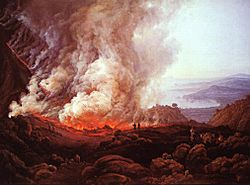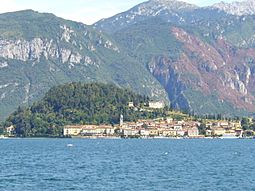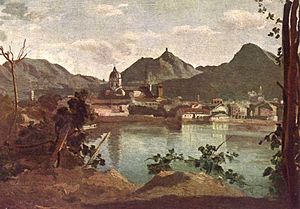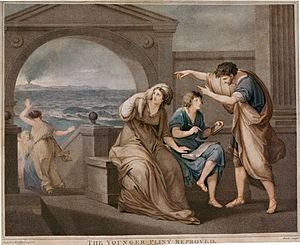Pliny the Younger facts for kids
Quick facts for kids
Pliny the Younger
|
|
|---|---|
| Gaius Plinius Caecilius Secundus | |

Statue of Pliny the Younger on the facade of Cathedral of S. Maria Maggiore in Como
|
|
| Born |
Gaius Caecilius Cilo
AD 61 |
| Died | c. AD 113 (aged approximately 52) |
| Occupation | Politician, judge, author |
| Parents |
|
Gaius Plinius Caecilius Secundus, also known as Pliny the Younger, was an important Roman lawyer, writer, and government official. He was born in 61 AD and lived until about 113 AD. His uncle, Pliny the Elder, helped raise and teach him.
Pliny the Younger wrote many letters, and 247 of them still exist today. These letters are very important because they tell us a lot about life in Ancient Rome. Some letters were sent to emperors or famous people like the historian Tacitus. Pliny worked for Emperor Trajan (who ruled from 98 to 117 AD). His letters to Trajan show us how the emperor and his governors worked together.
Pliny moved up through many government jobs in Rome. He was friends with the historian Tacitus. He also met other well-known thinkers of his time, like the philosophers Artemidorus and Euphrates the Stoic.
Contents
Pliny's Early Life
Childhood and Family
Pliny the Younger was born in a town called Novum Comum (today known as Como) in Northern Italy. This was around 61 AD. His father was Lucius Caecilius Cilo, and his mother was Plinia Marcella. Plinia was the sister of Pliny the Elder, a very famous and smart person in the Roman Empire. Pliny the Younger looked up to his uncle and even wrote about how his uncle worked on his huge book, Naturalis Historia.
Pliny's father died when Pliny was young. So, Pliny probably lived with his mother. His guardian, who was in charge of his education, was Lucius Verginius Rufus. This man was famous for stopping a rebellion against Emperor Nero in 68 AD.
Pliny first learned at home. Then, he went to Rome for more schooling. There, he learned how to be a good speaker from famous teachers like Quintilian. During this time, Pliny became very close to his uncle, Pliny the Elder.
A New Name and Inheritance
In 79 AD, when Pliny the Younger was about 17 or 18, a terrible event happened. His uncle, Pliny the Elder, died trying to help people during the eruption of Mount Vesuvius. In his will, Pliny the Elder left his property to his nephew. He also formally adopted Pliny the Younger. Because of this, Pliny the Younger changed his name from Gaius Caecilius Cilo to Gaius Plinius Caecilius Secundus.
Marriages
Pliny the Younger married three times. His first marriage was when he was very young, around 18. His first wife died at age 37. He married a second time, but we don't know exactly when. His third wife was named Calpurnia. Pliny wrote letters showing how much he loved Calpurnia. He also wrote about his sadness when they lost a child.
Death
Pliny is believed to have died suddenly around 113 AD. This happened while he was working in a Roman province called Bithynia-Pontus. His letters do not mention any events after this date.
Pliny's Career
Pliny was born into the equestrian rank. This was a group of wealthy Romans, just below the senators. They often held important government and military jobs. Pliny started his career at age 18. He followed the usual path for equestrians at first. But unlike most, he was later elected to the higher rank of Quaestor in his late twenties, which allowed him to enter the senatorial order.
Pliny was very active in the Roman legal system. He worked a lot in the centumviral court, which handled cases about inheritances. Later, he became a well-known lawyer. He often spoke for or against people in trials. These trials involved governors of Roman provinces.
Pliny's career is a great example of how Roman public officials worked. He managed to survive and even rise in rank under several different emperors, including the disliked Domitian. This shows he was very skilled and adaptable.
Career Highlights
Here are some of the important jobs Pliny held:
| c. 81 | He was one of the judges in the centumviral court. |
| c. 81 | He served as a staff officer in the Roman army in Syria. |
| 80s | He was an officer in the noble group of knights. |
| Later 80s | He became a member of the Roman Senate. |
| 88 or 89 | He was a Quaestor, working closely with the Emperor. |
| 91 | He became a Tribune of the People. |
| 93 | He served as a Praetor, a high-ranking judge. |
| 94–96 | He was in charge of the military treasury. |
| 98–100 | He was in charge of the treasury of Saturn. |
| 100 | He became a Suffect consul. |
| 103–104 | He was elected as an Augur, a religious official. |
| 104–106 | He was in charge of the banks of the Tiber. |
| 104–107 | He was a member of Emperor Trajan's legal council three times. |
| 110 | He became the Roman governor of the Bithynia et Pontus province. |
Pliny's Writings
Pliny wrote his first work, a play in Greek, when he was just 14. He also wrote many poems during his life, but most of them are now lost. Pliny was known as a great speaker. He admired Cicero, another famous Roman speaker.
Pliny's only speech that still exists today is called Panegyricus Traiani. He gave this speech in the Senate in 100 AD. It praised Emperor Trajan and described his actions. This speech is important because it tells us a lot about how the Emperor managed things like taxes, justice, and trade.
Epistulae (Letters)

The most important writings by Pliny that we still have are his Epistulae, which means Letters. These are personal letters he sent to his friends and colleagues. These letters give us a special look into Roman government history and daily life in the 1st century AD.
Two letters are especially famous. In them, Pliny describes the eruption of Mount Vesuvius in October 79 AD. This was when his uncle, Pliny the Elder, died (Epistulae VI.16, VI.20). Another important letter asks the Emperor for advice on how to deal with Christians (Epistulae X.96).
Letters about the Vesuvius Eruption
Pliny wrote the two letters describing the Vesuvius eruption about 25 years after it happened. He sent them because his friend, the historian Tacitus, asked him to. The first letter tells about the events leading up to the death of Pliny the Elder. His uncle was trying to rescue a friend named Rectina. The second letter describes what Pliny the Younger himself did during that time.
These two letters are very valuable for history. They give a very accurate description of the Vesuvius eruption. Pliny's details are so good that modern scientists who study volcanoes call these types of eruptions "Plinian eruptions."
Letter about Christians
Around 112 AD, Pliny was the Roman governor of Bithynia-Pontus (which is now part of Turkey). He wrote a letter to Emperor Trajan asking for advice on how to handle Christians. In this letter (Epistulae X.96), Pliny explained how he questioned people who were accused of being Christians. He had never investigated Christians before, so he asked the Emperor for clear rules. Pliny saved his letters and Trajan's replies. These are the earliest Roman documents that mention early Christians.
Letter about Voting
Pliny also wrote about how different ways of voting can change the outcome of an election. In a letter from 105 AD, he described a court case. He noticed that if they voted in a certain way, the accused person might be found guilty. But if they voted differently, the person might be found innocent. This shows that Pliny understood how voting rules can affect results.
Manuscripts
The first printed version of Pliny's Epistles was published in Italy in 1471. It was not complete. Later, between 1495 and 1500, a scholar named Giovanni Giocondo found a manuscript in Paris. This manuscript contained Pliny's tenth book of letters, which included his letters to Emperor Trajan. The first full collection of Pliny's letters was printed in 1508.
Pliny's Homes

Pliny was a very wealthy man and owned many villas, which were like large country homes. He wrote in detail about his villa near Ostia, in Laurentum, Italy. He also had two villas on Lake Como. One was called "Tragedy" because it was high on a hill. The other was called "Comedy" because it was low down by the lake. These names were a playful reference to how actors in tragedies wore tall shoes and actors in comedies wore flat shoes.
Pliny's favorite estate was his Villa "in Tuscis" in Umbria. This area was important for harvesting wood for Roman ships.
See also
 In Spanish: Plinio el Joven para niños
In Spanish: Plinio el Joven para niños
- Herculaneum
- Misenum
- Pompeii
- Stabiae



